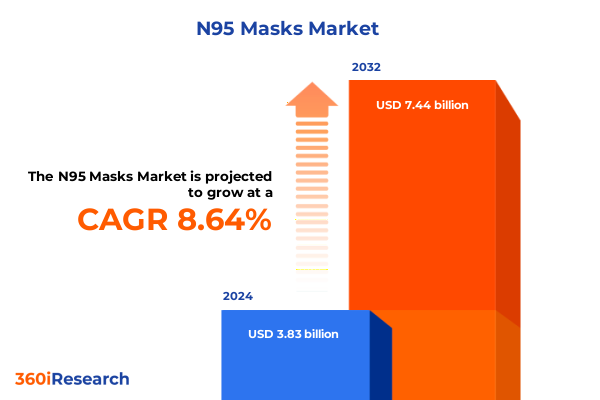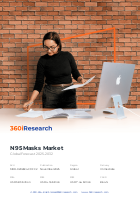The N95 Masks Market size was estimated at USD 3.83 billion in 2024 and expected to reach USD 4.16 billion in 2025, at a CAGR of 8.64% to reach USD 7.44 billion by 2032.

Unveiling the Comprehensive Introduction to the Evolving Landscape of Respiratory Protection: Trends, Innovations, and Driving Forces Shaping N95 Masks
The global focus on respiratory protection has never been more pronounced, as N95 masks have emerged as indispensable assets for safeguarding public health and resilient supply chains. Over the past decade, these filtering facepiece respirators have transcended their industrial origins to become household essentials, driven by evolving occupational safety regulations, heightened awareness of airborne contaminants, and unprecedented public health exigencies. Consequently, manufacturers, regulators, and end users alike are navigating a dynamic environment shaped by technological advancement, stringent performance standards, and shifting consumer expectations.
Examining the Pivotal Technological, Regulatory, and Behavioral Transformations Revolutionizing the N95 Mask Framework in a Post-Pandemic Global Environment
In recent years, seismic shifts have transformed the N95 mask segment into a crucible of innovation and regulatory evolution. Technological breakthroughs have ushered in prototypes capable of real-time health monitoring through integrated biosensors, a testament to the intersection of IoT and personal protective equipment as seen in emerging smart mask solutions that analyze breath biomarkers on the fly. Concurrently, certification bodies have tightened performance requirements and labeling protocols to address counterfeit risks and ensure consistent filtration efficacy. Consumer behavior has also evolved, with heightened demand for reusable models that align with sustainability goals and digital connectivity through brand-operated e-commerce platforms. These transformative forces now define the competitive battleground, compelling stakeholders to rethink product design, distribution strategies, and regulatory engagement to keep pace with an accelerated market trajectory.
Analyzing the Cumulative Effects of US Tariff Policies on N95 Mask Production Costs, Supply Chain Resilience, and Domestic Manufacturing Competitiveness in 2025
United States tariff policies have emerged as a critical factor influencing N95 mask economics and supply chain configurations heading into 2025. Persistent Section 301 duties on respirators and related textile masks have risen to 25 percent as of January 1, 2025, with provisions that escalate to 50 percent in subsequent years for certain categories. These cumulative duties have driven many importers to reconfigure sourcing strategies, pivoting toward regional manufacturing hubs or domestic production incentives to mitigate cost pressures. Despite these measures, U.S. producers continue to advocate for stronger enforcement of Buy American provisions and supplemental subsidies to offset the price differential created by alternative low-cost suppliers in Southeast Asia. The net effect of these tariff adjustments is a recalibrated competitive landscape where supply resiliency and strategic partnerships play an increasingly central role in ensuring inventory continuity and stable pricing.
Decoding Critical Segmentations by Product Type, End User, Distribution Channel, and Certification to Reveal Hidden Dynamics in the N95 Mask Market
A nuanced market analysis must capture how product type, end user, distribution channel, and certification converge to shape N95 mask dynamics. Product type segmentation distinguishes disposable single-use respirators from reusable variants, with the latter further bifurcated into smart models equipped with sensors and standard offerings prioritizing durability. End user segmentation spans consumer markets-where do-it-yourself enthusiasts and general public buyers exhibit distinct preferences-to healthcare settings that demand stringent compliance and industrial applications requiring robust performance under challenging conditions. Distribution channels evolve from traditional offline models involving wholesalers and pharmacy outlets to digital-first strategies leveraging brand websites alongside third-party marketplaces. Certification filters the market through CE-marked products complying with European PPE directives and NIOSH-approved respirators meeting U.S. occupational safety criteria.
This comprehensive research report categorizes the N95 Masks market into clearly defined segments, providing a detailed analysis of emerging trends and precise revenue forecasts to support strategic decision-making.
- Product Type
- End User
- Distribution Channel
- Certification
Illuminating Regional Variations in Adoption, Regulation, and Distribution Across the Americas, Europe-Middle East-Africa, and Asia-Pacific for N95 Masks
Regional insights reveal how regulatory frameworks, supply chain networks, and end user receptivity vary across the Americas, Europe-Middle East-Africa, and Asia-Pacific. In the Americas, particularly the United States, NIOSH-approved filtering facepieces command primary authority in workplace settings, mandating clear labeling and approved equipment list registration to ensure occupational safety compliance. Meanwhile, in Europe-Middle East-Africa, the PPE Regulation EU 2016/425 and Medical Device Regulation EU 2017/745 set rigorous conformity assessment procedures, necessitating CE marking through designated Notified Bodies to validate product safety and performance. Across the Asia-Pacific region, manufacturing agility and cost competitiveness have solidified this zone as a key production hub, though divergent national standards and emerging quality assurance frameworks require suppliers to accommodate localized certification requirements and evolving trade policies.
This comprehensive research report examines key regions that drive the evolution of the N95 Masks market, offering deep insights into regional trends, growth factors, and industry developments that are influencing market performance.
- Americas
- Europe, Middle East & Africa
- Asia-Pacific
Spotlighting Pioneering Manufacturers and Innovators Redefining N95 Mask Standards through Product Innovation, Strategic Partnerships, and Operational Excellence
Leading players and innovative challengers are reshaping the N95 mask arena through targeted investments, product enhancements, and strategic alliances. As a cornerstone brand in respiratory protection, 3M has reinforced its commitment to disaster readiness by pledging millions of NIOSH-approved units to global relief efforts and expanding its emergency stockpile collaborations to ensure rapid deployment during crisis events. Kimberly-Clark has distinguished its offerings by engineering a breathable pouch-style respirator that exceeds minimum performance thresholds for filtration efficacy and wearer comfort, leveraging patented headstrap technology to elevate the user experience in both healthcare and industrial contexts. Concurrently, specialized startups are pioneering next-generation smart masks that blend real-time analytics with adaptive fit functionality, opening new avenues for personalized respiratory monitoring and proactive health management.
This comprehensive research report delivers an in-depth overview of the principal market players in the N95 Masks market, evaluating their market share, strategic initiatives, and competitive positioning to illuminate the factors shaping the competitive landscape.
- 3M Company
- Honeywell International Inc.
- Moldex-Metric, Inc.
- Kimberly-Clark Corporation
- Alpha Pro Tech, Ltd.
- Prestige Ameritech Holdings, Inc.
- Gerson Company, LLC
- DemeTech Corp.
- Dynarex Corporation
- San Huei Enterprise Co., Ltd.
Delivering Actionable Recommendations for Industry Leaders to Navigate Market Complexities, Drive Growth, and Seize Emerging N95 Mask Opportunities
To navigate this complex and rapidly evolving market, industry leaders should prioritize four strategic imperatives. First, investing in research and development for reusable smart masks can unlock differentiation while aligning with sustainability mandates and user demand for connected health solutions. Second, diversifying supply chain footprints across nearshore and onshore facilities will mitigate risks posed by tariff fluctuations and geopolitical frictions, ensuring seamless inventory flow and cost control. Third, cultivating direct-to-consumer channels-especially brand-operated e-commerce platforms-can enhance customer engagement, streamline go-to-market execution, and bolster brand equity in the face of price-driven competition. Finally, proactively engaging with regulatory bodies and standards organizations will accelerate conformity processes for new products, reduce time to market, and reinforce stakeholder trust in product safety and efficacy.
Detailing a Robust Multi-Source Research Methodology Combining Expert Interviews, Secondary Data Analysis, and Rigorous Validation Techniques for Reliability
This analysis rests on a rigorous multi-step research methodology combining primary and secondary sources. Expert interviews were conducted with respiratory protection specialists, regulatory consultants, and procurement executives to capture real-world perspectives on evolving standards and commercial strategies. Secondary research synthesized industry publications, regulatory databases, and peer-reviewed academic work to map certification requirements, tariff structures, and technological innovations. All findings were validated against authoritative sources, including official guidance from NIOSH, USTR, and EU regulatory bodies, and cross-referenced to eliminate inconsistencies. The triangulated approach ensures a robust, holistic view of the N95 mask landscape, empowering decision-makers with reliable insights.
This section provides a structured overview of the report, outlining key chapters and topics covered for easy reference in our N95 Masks market comprehensive research report.
- Preface
- Research Methodology
- Executive Summary
- Market Overview
- Market Insights
- Cumulative Impact of United States Tariffs 2025
- Cumulative Impact of Artificial Intelligence 2025
- N95 Masks Market, by Product Type
- N95 Masks Market, by End User
- N95 Masks Market, by Distribution Channel
- N95 Masks Market, by Certification
- N95 Masks Market, by Region
- N95 Masks Market, by Group
- N95 Masks Market, by Country
- Competitive Landscape
- List of Figures [Total: 28]
- List of Tables [Total: 621 ]
Summarizing Critical Insights and Strategic Implications from the N95 Mask Analysis to Empower Stakeholders with Actionable Knowledge for Informed Decisions
As the N95 mask sector continues its trajectory of technological advancement and regulatory refinement, stakeholders must remain vigilant in adapting to shifting market forces. The interplay of smart mask innovation, evolving certification landscapes, and trade policy developments underscores the necessity of strategic agility. Whether aligning production with domestic incentive schemes, harnessing digital channels for targeted outreach, or embedding real-time health monitoring capabilities within reusable designs, decision-makers who integrate these insights into their strategic roadmaps will be best positioned to capitalize on emerging opportunities while safeguarding supply resilience.
Engage with Ketan Rohom to Access an In-Depth N95 Mask Market Research Report Packed with Unmatched Industry Intelligence
To take your understanding of the N95 mask landscape to the next level, connect directly with Ketan Rohom, Associate Director of Sales & Marketing. By engaging with him, you will gain access to a comprehensive, meticulously researched market research report that unpacks the latest trends, regulatory developments, and competitive dynamics. This report is designed to equip your team with the data-driven insights needed to refine your strategic plans, optimize supply chains, and accelerate innovation in respiratory protection solutions. Reach out today to secure your copy and tap into an expert resource that will empower you to make informed decisions and maintain a competitive edge.

- How big is the N95 Masks Market?
- What is the N95 Masks Market growth?
- When do I get the report?
- In what format does this report get delivered to me?
- How long has 360iResearch been around?
- What if I have a question about your reports?
- Can I share this report with my team?
- Can I use your research in my presentation?




